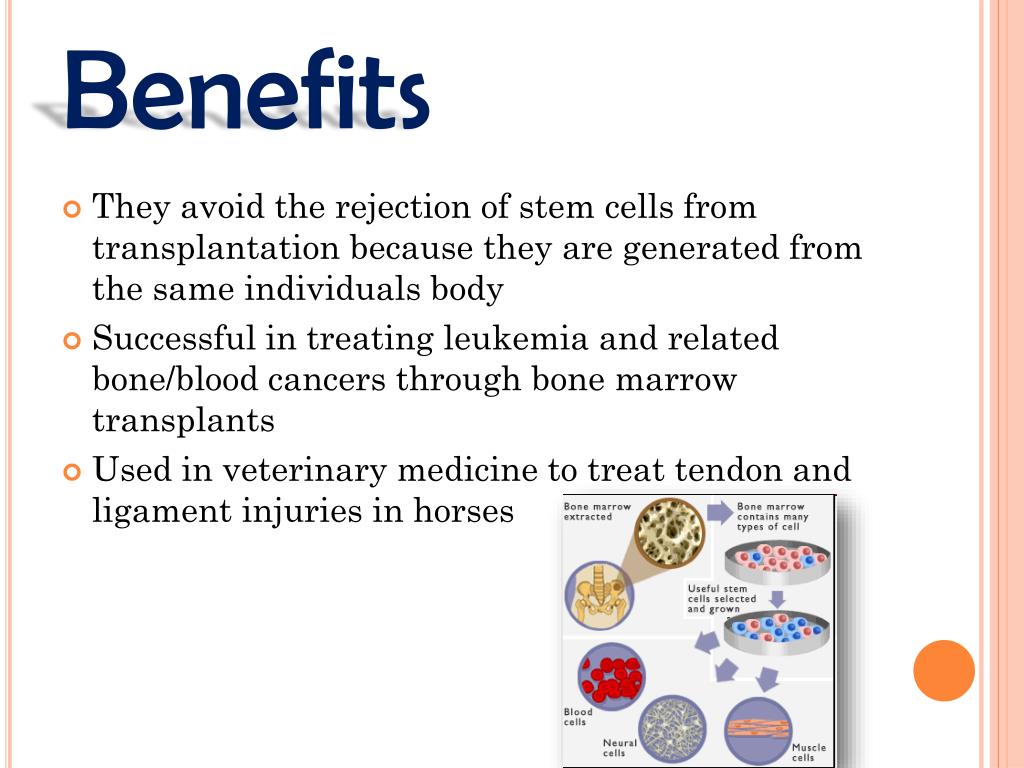

Embryos could come to be viewed as a commodity, and not as an embryo that could develop into a person.For therapeutic cloning, is it right to create embryos for therapy, and destroy them in the process?.A source of embryonic stem cell is unused embryos produced by in vitro fertilisation.Cultured stem cells could be contaminated with viruses which would be transferred to a patient.Mutations have been observed in stem cells cultured for a number of generations, and some mutated stem cells have been observed to behave like cancer cells.The difficulty in obtaining and storing a patient's embryonic stem cells.The difficulty in finding suitable stem cell donors.

There is no guarantee of how successful these therapies will be, for example in the use of stem cells in healing damage caused by Parkinson's disease.Some variables which would be considered when discussing stem cells include: Clinical issues Sometimes, there are no right or wrong answers. It is important to obtain a balanced view. They will also depend on whether the stem cells are to be used for therapy or research. These issues will be different for growth and transplant of adult stem cells, embryonic stem cells and therapeutically-cloned stem cells. There are clinical, ethical and social issues with their use. treating patients with currently untreatable conditions.Patients could be exploited by paying for expensive treatments and being given false hope of a cure as stem cell therapies are only in their developmental stages.Benefits and risks associated with the use of stem cells in medicine Much of the research is being carried out by commercial clinics, so reported successes are not subject to peer review.Whether the benefits of stem cell use outweigh the objections.Educating the public about what stem cells can, and can’t do, is important.At what stage of its development should an embryo be regarded as, and treated as a person?.For therapeutic cloning, is it right to create embryos for therapy and destroy them in the process?.A source of embryonic stem cells is unused embryos produced by IVF (in vitro fertilisation).These would have to be collected before birth - some clinics offer to store blood from the umbilical cord when a person is born. The current difficulty in finding suitable stem cell donors.There is no guarantee how successful these therapies will be, for example, the use of stem cells in replacing nerve cells lost in Parkinson's disease patients.Sometimes, there are no right or wrong answers, or even answers at all. These issues will be different for growth and transplant of adult, embryonic and therapeutically-cloned stem cells. But there are clinical, ethical and social issues with their use. Stem cells have great potential in treating patients with currently untreatable conditions, growing organs for transplants, and research. when blood cells have been destroyed by cancer treatmentīenefits and risks associated with the use of stem cells in medicine.in cases of blood cell cancer such as leukaemia and lymphoma.Bone marrow cells will differentiate into different types of blood cell. Bone marrow transplants are an example of adult stem cell transplant. The best source is the five-day-old embryo.Īdult stem cells will differentiate into a narrower range of cell types. in cases of spinal cord or brain injury, that have led to paralysisĮmbryonic stem cells can differentiate into a wider range of cell types, but are difficult to obtain and their use raises ethical challenges.in cases of multiple sclerosis, which can lead to paralysis.They could be used to replace cells that have been damaged or destroyed, eg:


They therefore have the potential to be transplanted into patients to treat medical conditions and disease. Stem cells can divide to produce new cells, which can then divide into different cell types.


 0 kommentar(er)
0 kommentar(er)
